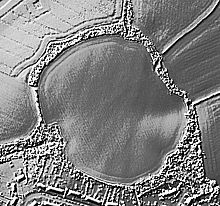|
|
|
|
Norton Camp (Somerset)Hillfort
|
||||||||||||||||||||||||
|
|
|
Images (click to view fullsize) |
|
Photographs: Maps / Plans / Diagrams:
Maps / Plans / Diagrams:
|
Fieldnotes |
|
|
Visited 18.1.14 Directions: The Hillfort is in the village of Norton Fitzwarren, which is on the outskirts of Taunton. Although Norton Fitzwarren is only a small place the Hillfort is a little tricky to find as it is not sign posted and is almost hidden in a residential area. Best advice I can give is to look for the church and take the roads to the north of it. There is a dedicated small car park for the Hillfort / nature reserve – which is signposted at this point. Once you have found the car park, it is only a two minute walk up some steps and along a path (through trees) to the Hillfort. A muddy path follows the circumference of the site but a fence prevents you from entering the centre of the Hillfort which appears as though it is now used for crop? The entire bank of the rampart is covered in trees. From the inside, the bank is about 1m in height, from the outside 2-3m in height. The houses to the south back right up to the southern defences. The garden fence is literally up against the rampart. I am sure the house builders wouldn’t be allowed to get away with that in this day and age? Oh I forgot about Old Oswestry……………..! Although there isn’t a huge amount to see this is an easy Hillfort to access and is worth seeking out if you happen to be in the area. |
Posted by CARL 21st January 2014ce |
Folklore |
|
Norton Fitzwarren Church.From the Proceedings of the Somerset Archaeology and Natural History Society 1872. The Proceedings for 1898 mention the somewhat grisly detail that "Even in our own day the inhabitants will tell you of the pestiferous reptile that once upon a time lived on the hill, bred from the corruption of human bodies, breathing disease and death around.". |
 Posted by Rhiannon
Posted by Rhiannon21st January 2014ce Edited 21st January 2014ce |
|
It is said that "Norton was a market town When Taunton was a vuzzy down." For you city dwellers out there, vuzzy means furzey, which means covered in gorse. (mentioned in Grinsell's 'Folklore of Prehistoric Sites in Britain') |
 Posted by Rhiannon
Posted by Rhiannon9th June 2004ce Edited 25th July 2010ce |
| Following a battle at this hillfort a dragon was said to have been formed by ‘spontaneous generation’ from the pile of dead bodies. It terrorised the neighbourhood until it was killed by a local hero known as Fulk Fitzwarine. The events are commemorated on a carved and painted rood-screen (circa 1500) in the church (or did the rood screen inspire the dragon tale?). |
 Posted by pure joy
Posted by pure joy21st March 2003ce |

